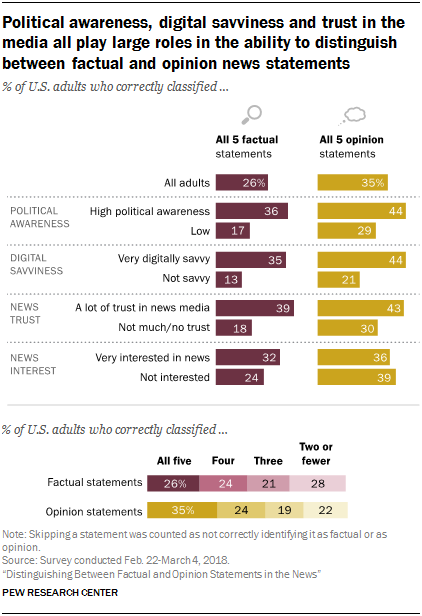Americans Struggle To Identify Fact Vs Opinion, Only 25 Percent Correctly Separate The Two [Survey]
In the age of digital media and fake news, separating fact from fiction is a daunting and time consuming endeavor which requires significant effort and self-awareness on the readers’ end. New data released by Pew Research Center gives credence to this sentiment, shedding a light on partisanship, political awareness, and digital savviness.
Pew’s Amy Mitchell, Jeffrey Gottfried, Michael Barthel, and Nami Sumida wrote the following.
“New Pew Research Center survey of 5,035 U.S. adults examines a basic step in that process: whether members of the public can recognize news as factual – something that’s capable of being proved or disproved by objective evidence – or as an opinion that reflects the beliefs and values of whoever expressed it.”
The findings from the survey, conducted between February 22 and March 8, 2018, on 5,035 U.S. adults, shows that even the most basic task of distinguishing between factual and opinion statements presents a significant challenge.
For instance, 36 percent of Americans with a high level of political awareness (defined as knowledge about politics and regular political news diet) correctly identified all five factual news statements. Seventeen percent of surveyed Americans with low political awareness correctly identified all five factual news statements provided by the Pew Research Center.
Similarly, 44 percent of Americans with a high level of political awareness correctly identified all five opinion statements, and 29 percent of surveyed American adults with a low level of political awareness correctly identified all five opinion statements.
Digital savviness of survey participants was also taken into consideration. Only 35 percent of very digitally savvy individuals correctly identified all five factual news statements, and 44 percent of very digitally savvy Americans correctly identified all five opinion statements. Those who are not digitally savvy were much less successful, with only 13 percent of such participants correctly identifying all five factual news statements, and 21 percent of those not as technologically savvy correctly identified all five opinion statements.
Trust plays a part too. Thirty-nine percent of Americans who reported having a lot of trust in news media correctly identified 39 percent of all five factual statements, while those who reported having not much or no trust correctly identified 18 percent of factual statements. Likewise, 43 percent of surveyed Americans who reported having a lot of trust in news media correctly identified all five opinion statements, while 30 percent of Americans who reported having not much or no trust in news media correctly identified 30 percent of all five opinion statements.
Of those very interested in news, 32 percent were able to correctly identify all five factual statements, and 36 percent were able to correctly identify all five opinion statements. Those who reported a lack of interest in news correctly identified 24 percent of factual statements, and 39 percent of opinion statements.
Partisanship and political affiliations, according to Pew’s survey, have a say in one’s ability to correctly separate fact from fiction. Both Republicans and Democrats show a propensity to label both factual and opinion statements as factual when they appeal to their political side.
As Reuters noted, when Americans call a statement “factual” they consider it accurate, results of Pew’s survey show, which means they tend to disagree with factual statements they incorrectly label as opinions.










